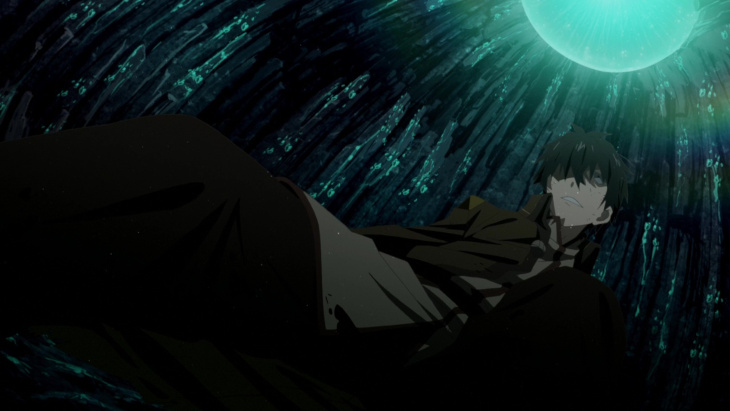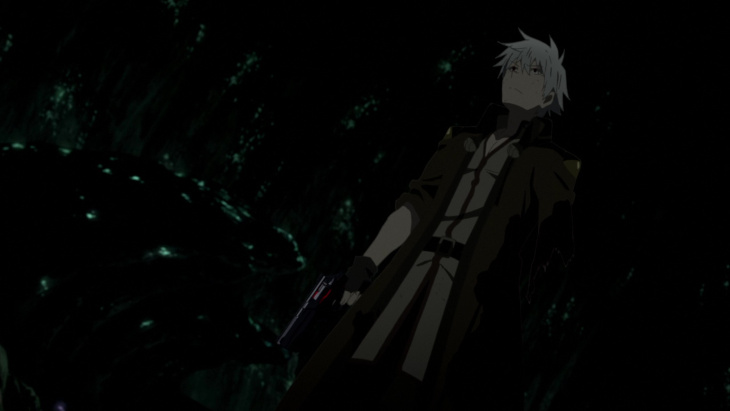
“What the hell happened to me?… Damn, I look like a demon.”
Ha HA! And here I thought I’d have to wait for DanMachi Season 2 for my fill of white haired protagonists working their way through levels of a dungeon while gradually becoming more and more overpowered. I joke, but Arifureta Shokugyou de Sekai Saikyou is probably what you would end up with if you threw DanMachi, Reincarnated as a Slime, and The Count of Monte Cristo into a blender and hit frappe. Well, you’d either get this or a lot of knotted white hair. It’s hard to say which. Still, I may be poking fun at it, but combining aspects of those three premises doesn’t sound like a particularly bad idea. One thing Danmachi and Reincarnated as a Slime have in common is they both feature very optimistic and positive protagonists, but mix in a bit of Monte Cristo and you have a recipe for a compelling tortured character with a chip on his shoulder. To put it bluntly, Arifureta: From Commonplace to World’s Strongest has me hooked. It’s presentation and narrative structure are notably sloppy, so I don’t know if it will maintain my interest, but there are enough interesting factors at play to make me wonder how it will play out.

Our main character is Nagumo Hajime, and when we first meet him, he’s going through the type of experience that is usually reserved for characters wearing red. During an expedition into a dungeon a suspicious case of friendly fire leaves him tumbling into the abyss. Finding himself in a much lower part of the dungeon than he could reasonably survive on his own, he is forced to flee the vicious monsters that make their home there by using his magical abilities to create a burrow to hide in, though he loses an arm in the process. Fortunately, he finds a rare gem that produces healing elixir, but he’s still down an arm and with nothing else to eat he is forced to trap monsters and feed on their toxic flesh. He soon finds that by combining their flesh with the elixir he is able to absorb their physical abilities though it leaves him physically changed. With his newfound abilities, Hajime begins stockpiling power with the intent of returning to the surface and confronting the one who left him for dead. I really just want to take a few minutes to go yell at Rising of the Shield Hero, “This is how you make a put-upon protagonist likeable!!!” As bitter and angry as Hajime may be in this episode, there is always a part of him that remains likable and grounded, and it feels as if he knows where to focus that anger. While he does at one point refer to his classmates betraying him in a rather general sense, I think that is because the episode wants to mask who the specific culprit was.

The production is decent, but I’d be lying if I said this was among the best looking shows of the season. Many of the monsters in this episode have interesting designs, but there is a CG dragon that stands out as the exception. It isn’t too terrible, but it is hardly a smooth integration. This is a co-production between White Fox and Asread. White Fox has a decent enough track record, but Asread has a pretty mediocre history, even though they’ve been around longer. The character models aren’t particularly unique either, so it didn’t come as much of a surprise to learn that Arifureta initially began as a novel series. Despite all of these gripes, the visuals aren’t bad, just mildly generic.
Before I wrap up, a few Notes and Nitpicks:
- I was originally going to make a comment about how we keep seeing images of that Queen from Dance in the Vampire Bund (There’s a timely anime reference), but based on what I read of the series synopsis, she actually is a vampire. Arifureta, it’s sometimes hard to say you aren’t derivative.
- If you’re like me, you’re probably wondering, “Wasn’t this an isekai series?” Evidently it is, but the first episode makes no references to that fact, as far as I can tell.
- I get the feeling that Hajime would envy Rimiru’s ability to eat creatures quickly and with little fuss.
- I was mainly referring to the novel The Count of Monte Cristo earlier in the review, but then I remembered that Gankutsuo is a thing.




Add comment